Keywords
|
| microstrip antenna, monopole, slot, ominidirectional, parasitic strip |
INTRODUCTION
|
| Emerging trends in microwave communication systems, monopole microstrip antennas are popular because of compact size, simple in design, low cost and capable of operating more than one band of frequencies. Owing to its thin profile, light weight, low cost, planar configuration and easy fabrication, the monopole microstrip antenna is the better choice for these requirements. Number of investigations have been reported in the literature an monopole microstrip antennas such as parasitic planar element for bandwidth enhancement of 1 to 9 GHz [3], band-rejected antenna with the parasitic strip for UWB [4], microstrip-fed monopole antenna with a shorted parasitic element for wideband covering Bluetooth/ISM, 2.5 GHz WiMAX, 3.5 GHz WiMAX, and 5.2/5.8 GHz WALAN [5], a triple-band CPW-fed microstrip antenna for WLAN and WiMAX [6], a new triple-band CPW-fed monopole antenna for WLAN and WiMAX [7], slotted rectangular microstip antenna for bandwidth enhancement [8], open L-slot antenna with rotated rectangular patch for bandwidth enhancement [9] etc. But the design and development of parasitic strip monopole microstrip antenna for HIPERLAN/2 and UWB operation is rarely found in the literature. Further most of the antennas presented in the literature are either complex in their structure or bigger in size and hence require carful manufacturing procedure than that of the regular microstrip antenna for practical applications |
DESIGN OF ANTENNA GEOMETRY
|
| The art work of the proposed antenna is sketched by using computer software Auto-CAD to achieve better accuracy and is fabricated on low cost FR4-epoxy substrate material of thickness of h = 0.16 cm and permittivity εr = 4.4. Figure 1 shows the top view geometry of parasitic strip rectangular monopole microstrip antenna (PRMA). In Fig.1 the area of the substrate is L * W cm. On the top surface of the substrate a ground plane of height which is equal to the length of microstripline feed Lf is used on either sides of the microstripline with a gap of 0.1 cm. On the bottom of the substrate a continuous ground copper layer of height Lf is used below the microstripline. The PRMA is designed for 3 GHz of frequency using the equations available for the design of conventional rectangular microstrip antenna in the literature [2]. The length and width of the rectangular patch are Lp and Wp respectively. The feed arrangement consists of quarter wave transformer of length Lt and width Wt which is connected as a matching network between the patch and the microstripline feed of length Lf and width Wf. A semi miniature-A (SMA) connector is used at the tip of the microstripline feed for feeding the microwave power. In Fig.1 a parasitic strip is used around the radiating patch with a gap of 0.2 cm. |
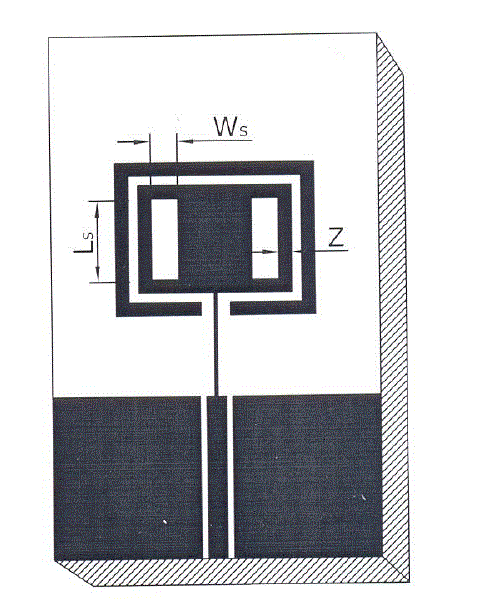 Fig. 1 Top view geometry of PRMA Fig. 1 Top view geometry of PRMA |
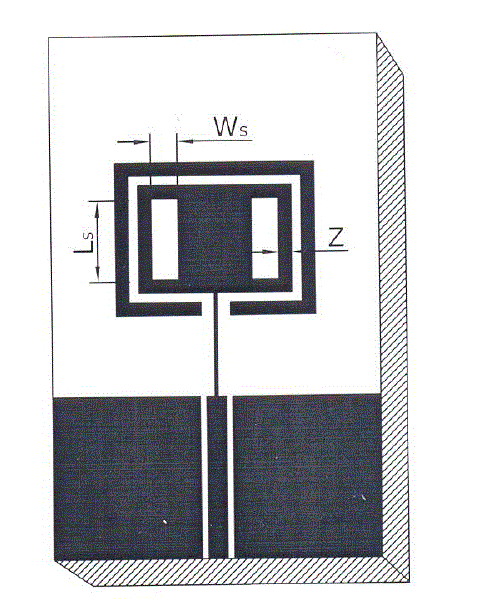
Fig. 2 Top view geometry of SPRMA |
| Figure 2 shows the geometry of slotted parasitic strip rectangular monopole microstrip antenna (SPRMA). In this figure rectangular slots are loaded on the radiating patch with a gap of Z (i.e.0.25 cm) from its vertical sides. The length and width of the slots are Ls and Ws respectively. The other geometry of Fig. 2 remains same as that of Fig.1. The design parameters of the proposed antenna is shown in Table 1 |
 |
EXPERIMENTAL RESULTS AND DISSCUSION
|
| The antenna bandwidth over return loss less than -10 dB is tested experimentally on Vector Network Analyzer (Rohde & Schwarz, Germany make ZVK model 1127.8651). The variation of return loss verses frequency of PRMA is as shown in Fig. 4. From this graph the experimental bandwidth (BW) is calculated using the equations, |
 |
| were, f1 and f2 are the lower and upper cut of frequencies of the band respectively when its return loss reaches – 10 dB and fc is the centre frequency of the operating band. From this figure, it is found that, the antenna operates between 4 to 16 GHz and gives six resonant modes at f1 to f6, i.e. at 4.74, 6.30, 8.92, 12.97, 14.07 and 15.27 GHz. The magnitude of experimental -10 dB bandwidth measured for BW1 to BW6 by using the equation (1) is found to be 90 MHz (1.47 %), 1.11GHz (17.68 %), 1.56 GHz (16.93 %), 3.26 GHz (27.62 %), 960 MHz (6.74 %) and 760 MHz GHz (4.80 %) respectively. From Fig.2 it is clear that, the operating band BW2 covers HIPERLAN/2 i.e. from 5.72 to 6.83 GHz. |
| The resonant mode at 4.78 GHz is due to the fundamental resonant frequency of the patch and others modes are due to the novel geometry of PRMA. The multi mode response obtained is due to different surface currents on the patch. The fundamental resonant frequency mode shifts from 3 GHz designed frequency to 4.78 GHz due to the coupling effect of microstripline feed and top ground plane of PRMA. |
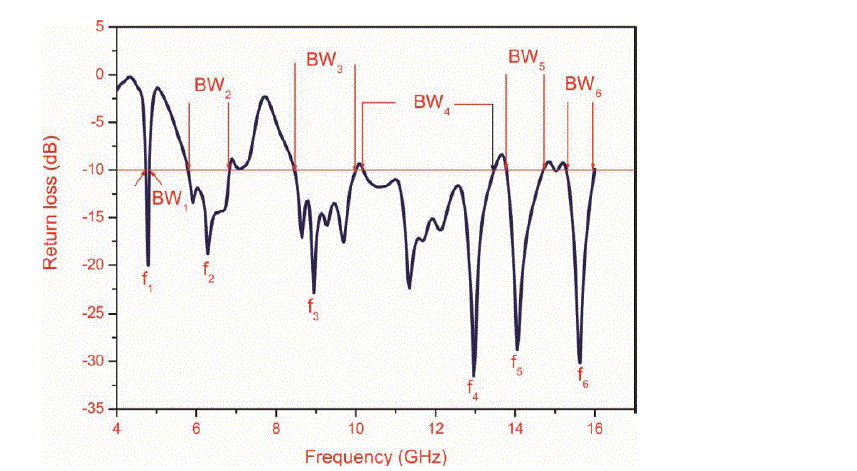
Fig. 3 Variation of return loss versus frequency of PRMA |
| Figure 4 shows the variation of return loss verses frequency of SPRMA. It is seen from this figure that, the antenna operates for five bands of frequencies BW7 to BW11. The magnitude of these operating bands measured at BW7 to BW11 is found to be 140 MHz (2.93 %), 930 MHz (14.77 %), 250 MHz (3.45 %), 1.46 GHz (15.88), and 5.59 GHz (42.33 %) respectively. From Fig. 4 it is seen that the f4, f5, and f6 of BW4, BW5 and BW6 of Fig.3 are merged together into a single band BW11 in this as shown in Fig.4. Further from Fig.4 it is clear that, the SPRMA is capable of widening its operating bands when compared to the operating bands of PRMA. Hence by controlling the location and dimension of slots on the patch antenna can be made to operate for desired frequency range. |
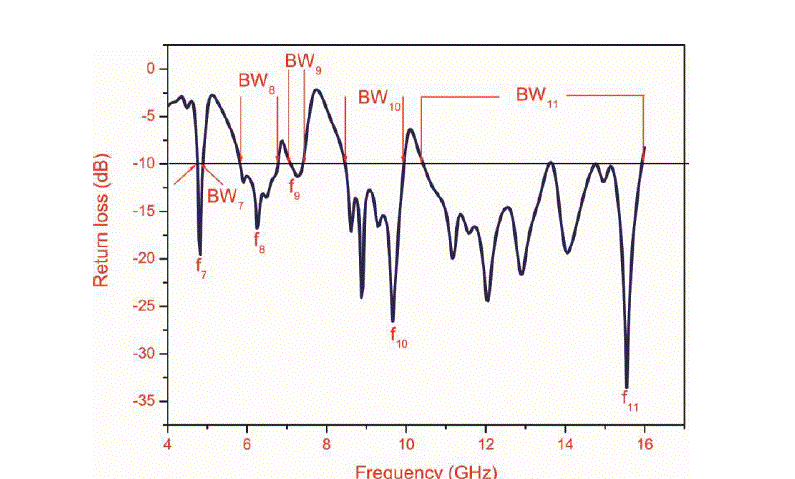
Fig. 4 Variation of return loss versus frequency of SPRMA |
| The gain of the proposed antennas is measured by absolute gain method. The power transmitted ‘Pt’ by pyramidal horn antenna and power received ‘Pr’ by antenna under test (AUT) are measured independently. With the help of these experimental data, the gain (G) dB of AUT is calculated by using the formula, |
 |
| where, Gt is the gain of the pyramidal horn antenna and R is the distance between the transmitting antenna and the AUT. Using equation (2), the peak gain of the proposed antennas measured in their operating bands is found to be 11.70 dB and 9.54 dB respectively. |
| The co-polar and cross-polar radiation pattern of PRMA and SPRMA is measured at 4.74 GHz and are shown in Fig 5 to 6 respectively. The obtained patterns are ominidirectional in nature |
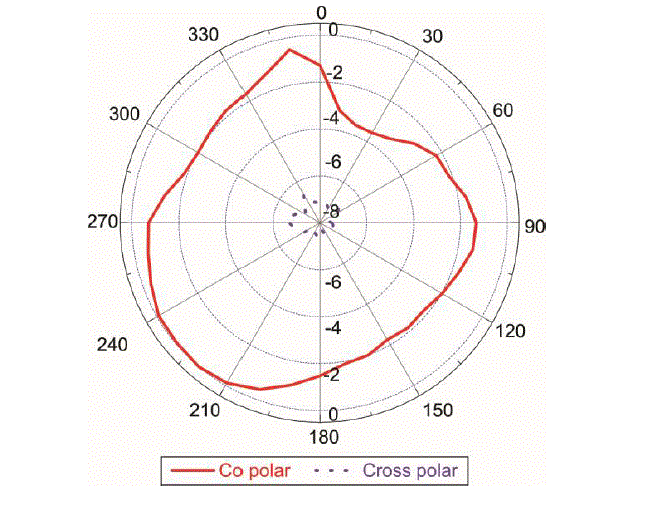
Fig. 5 Radiation pattern of PRMA measured at 4.74 GHz |
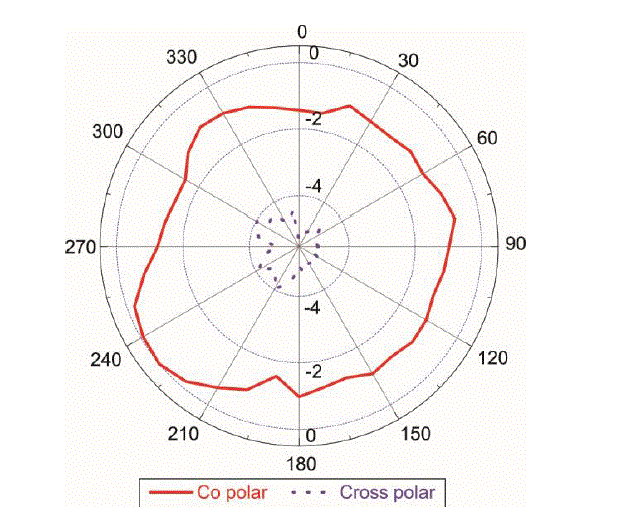
Fig. 6 Radiation pattern of SPRMA measured at 4.74 GHz |
CONCLUSION
|
| From the detailed experimental study, it is concluded that, the PRMA with microstripline feed is useful for HIPERLAN/2 (BW2 i.e. 5.72 to 6.83 GHz) and UWB applications. The antenna has simple structure which consists of a rectangular radiating patch of 2.34 X 3.04 cm2 with parasitic strip and use low cost substrate material FR4. The proposed antenna excites six resonant modes and gives peak gain of 11.70 dB. Further if the radiating patch is modified by loading rectangular vertical slots on the patch and antenna operates for five wide operating bands. In both the cases antenna operates in the frequencies range of 4 to 16 GHz and gives ominidirectional radiation characteristics. The proposed antennas may find application in HIPERLAN/2 and microwave communication systems. |
ACKNOWLEDGEMENTS
|
| The authors would like to thank Dept. of Sc. & Tech. (DST), Govt. of India. New Delhi, for sanctioning Vector Network Analyzer to this Department under FIST project. The authors also would like to thank the authorities of Aeronautical Development Establishment (ADE), DRDO Bangalore for providing their laboratory facility to make antenna measurements on Vector Network Analyzer |
Tables at a glance
|
References
|
- Constantine A. Balanis, Antenna theory analysis and design, John Wiley, New York, 1997
- I.J. Bahl and P. Bharatia, Microstrip antennas, Dedham, MA: Artech House, New Delhi, 1981.
- Zhi Ning Chen1 and Y. W. M. Chia1 “broadband monopole antenna with parasitic plan Element, microwave and optical technologyletters vol. 27, no.3, pp.209-210, 2000.
- Ki -hak kim and seong-ook park, „analysis of the small band-rejected antenna with the parasitic strip for UWB”, IEEE Trans Antennasand Propagat, vol. 54, no. 6, pp.1688-1692, 2006.
- C.-F. Tseng, C.-L. Huang, C.-H. Hsu, “microstrip-fed monopole antenna with a shorted parasitic element for wideband application”,Progress In Electromagnetics Research Letters, vol.. 7, 115–125, 2009.
- Vijeta, Davinder Parkash, “a triple-band CPW-fed microstrip antenna for WLAN and WiMAX applications”, BPR Technologia A Journal ofScience, Technology & Mangement, vol.1,no. 1, pp.77-85, 2012.
- Y.-Y. Cui, Y.-Q. Sun, H.-C. Yang, C.-L. “Ruan, A new triple-band CPW-fed monopole antenna for WLAN AND WiMAX applications”,Progress In Electromagnetics Research M, vol. 2, pp. 141–151, 2008.
- Jia- Yi Size, Kin-lu Wong, “Slotted rectangular microstip antenna for bandwidth enhancement”, IEEE Trans Antennas andPropagat vol. 48, no. 8, pp.1149-1152, 2000.
- K. Song, Y. Z. Yin, S. T Fan, Y. Z Wang and L. Zhang, “Open L-slot antenna with rotated rectangular patch for bandwidthenhancement”, Electron Lett. Vol. 45, no. 2, pp.1286 – 1288. 2009.
|